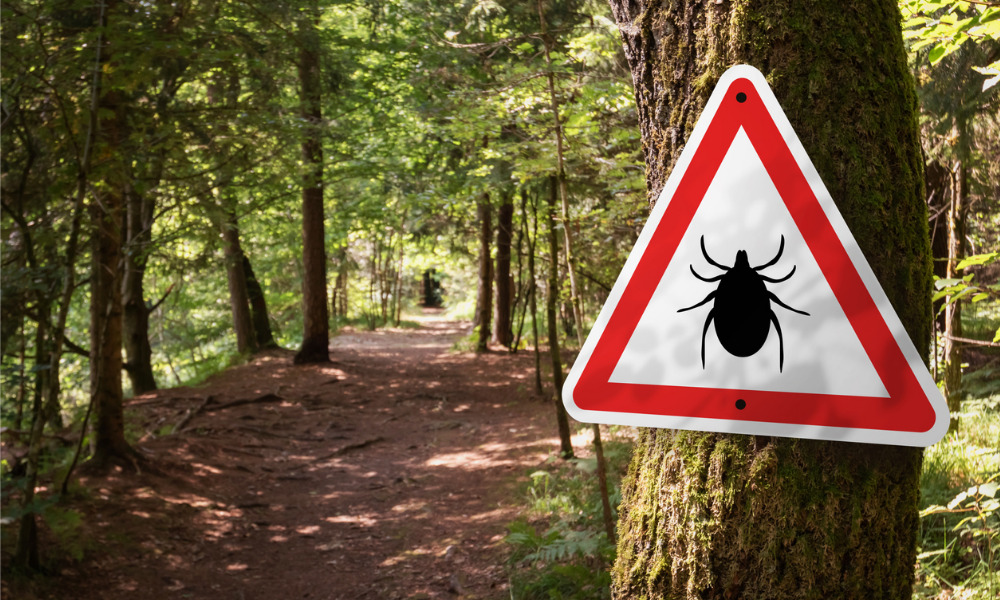How workers can protect themselves from dangerous arachnids

With the arrival of spring and the warmer months also comes the advent of tick season. Starting in April and May, it really hits its stride in June. With global warming, tick season is starting even earlier.
Ticks are arachnids which survive by feeding on the blood of animals and humans. Tick Talk says that there are over 40 species in Canada, and they typically prefer living in wooded areas or in tall grass. But they can even be found in urban areas such as parks or other green spaces.
Because of their prevalence in areas like these, most outdoor workers are at risk of being bitten by ticks. This includes tree planters, lumberjacks, foresters or fishers, grounds keepers, parks workers – and even camp counsellors.
Ticks are so small that they can be hard to spot on the body – but it is of utmost importance for workers to check for tick bites because they are far from benign.
Tick bites can be extremely dangerous for humans, for example workers may be a risk of contracting Lyme disease – an infection that spreads to humans through tick bites. And in an interview with the Canadian Lyme Disease Foundation (CanLyme), COS discovered that Lyme disease is on the rise in Canada and spreading rapidly.
The number of cases reported in Canada has increased dramatically. According to data from the federal government, the number has increased from 144 cases in 2009 to 917 cases in 2015. Not all ticks are carriers for Lyme disease, but it is nevertheless an important threat.
The consequences of the infection can be severe, but with hundreds of potential symptoms, it can be hard to diagnose. Jim Wilson, founder, CanLyme, told COS that most physicians in Canada will not give a Lyme diagnosis unless an individual had been in a known endemic area. Caught early, it can be treated with antibiotics, but the longer it lingers the harder it becomes to treat.
Common symptoms include flu-like symptoms (headache, fatigue, fever, etc.), hearing loss, insomnia, painful joints, rash at the site of the bite, etc.
So what can safety officers and employers do to ensure optimal worker safety amid tick season?
1. Educate workers on the danger posed by ticks. If a worker is in an environment where tick bites could pose a threat, this worker needs to be educated on how to properly manage their own safety during tick season. Sharing educational materials or putting up signage in communal areas are both easy ways to keep workers in the loop. Workers and employers also shouldn’t be lulled into a false sense of security during the colder months – ticks can come out to feed at temperatures as low as 4°C says Tick Talk.
2. Provide workers with the correct protective gear. Speaking with COS, Tammie Wheeler, administrative and safety coordinator at TimberWest, says that the organization encourages workers to tuck their pants into their work boots, and tuck their shirts in to prevent any unnecessary exposed skin. The whole body should be covered in clothing and tightly wrapped.
Can Lyme also recommends light-coloured clothing so that ticks can easily be spotted on the worker. After a shift, workers should also check any gear or equipment for ticks to ensure that they are not carrying them back into the workplace or at home.
3. Encourage workers to check for ticks after each shift. Workers should do body inspections to check for ticks. Any exposed skin is ripe for a tick bite. The Ontario Ministry of Labour recommends especially checking areas of the body such as behind the ears and knees, scalp, ankles, armpits, groin and navel.
If a worker finds a tick on their body, they need to carefully remove it and then go to visit a medical professional or a hospital to get tested for Lyme disease. Workers should also let their employers know, so that safety pros and employers can ensure that this is not an issue for other workers.
To remove a tick, the U.S. Centers for Disease Control and Prevention (CDC) says that while there are a number of removal devices on the market, a simple pair of clean tweezers should work fine. Use the tweezers to remove the tick carefully and steadily from the skin, making sure to also remove the mouth parts. Thoroughly clean and disinfect the bite area afterwards.





